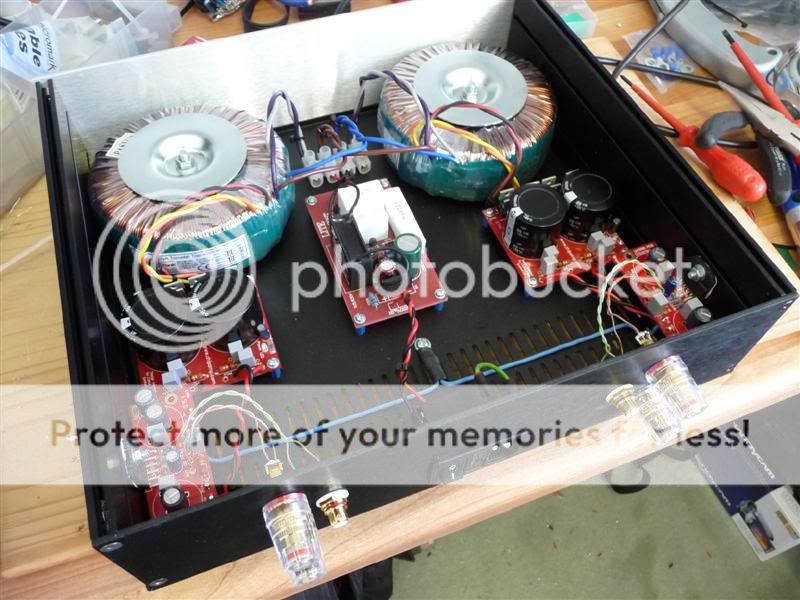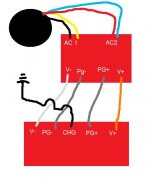Well I disconnected the V and PG's and the PSU didn't smoke out on me. So that rules out the error being on the psu amirite?
I guess I'll peel off the amp board tomorrow and give it a good eyeballing...
My diodes will be fine right? They got super-crazy hot when I ran it with the 10amp fuse but it seems ok now?
Okay so I noticed my psu is putting 40v off V- and the expected 34 off V+. Whats up there? I tried it with both of my transformers same result...
Gah! Tried my second amplifier board and it got hot again! Must be a problem with my psu?? Only the middle four diodes get hot and they heat up basically instantaneously.
Last edited:
Hi,
I see no mention of the mains light bulb tester.
Is it still on the shelf not being used?
Always plugged in! It glows dimly for a mo when I switch on but that's inrush current I imagine. Other than that it's dark when only the psu is hooked in.
I can't recall if it lit up with the amp board attached, I was pre-occupied with the humming and smoke.......

I'm hesitant to re-attach either of the amp boards until I figure out just why the V- is putting off more voltage than V+... seems wrong to me.
Incidentally I'm setting up monoblocks using 160VA 24,0 24,0 toroidals.... Transformer's fine right?
Last edited:
Check the diode polarities.
Much of this could be avoided by using these:
An externally hosted image should be here but it was not working when we last tested it.
No nonsense one piece bridge.
Well they're all mur860's with the metal tabs facing the big caps. So they can't possibly be out of polarity right?
I just plugged my OTHER psu into an amp board, the light buld glows full intensity but there is no immediate heat or humming.... stand by for a diagram.
PS MJ I'm switching the the IC Bridges after this!
I just plugged my OTHER psu into an amp board, the light buld glows full intensity but there is no immediate heat or humming.... stand by for a diagram.
PS MJ I'm switching the the IC Bridges after this!
This should be perfect??1?
It is perfect! I took them apart and put them back together and now they work magically.
Output level is too quiet though!!
I have NEVER had a situation with a mistake in component orientation nor in transformer/rectifier miss-wiring for any smoke.Always plugged in! It glows dimly..............................
.................., I was pre-occupied with the humming and smoke.......
The voltage drop across the bulb is very high. This results in a very low voltage drop across the transformer.
Simple maths says that if you apply 11Vac to a 110Vac transformer and you will get ~ one tenth of the output voltage, before the voltage drop of the rectifier. Similarly a 300VA transformer will be downrated to ~30VA when fed with 10% of mains voltage.
you might have <=5% of mains voltage across the transformer.
It is impossible in this bulb protected test to smoke the components.
I don't believe this.Always plugged in! ...................... and smoke.......:hot
Hi
I have just put together an amp for my father and I am using a soft-start module for the first time.

When I press the on switch my bulb filament glows dimly. My 2x300VA, 25vac secondaries measure 36vdc at the power supply rails.
Should the bulb glow at all, or is it glowing under load?
Thanks
I have just put together an amp for my father and I am using a soft-start module for the first time.

When I press the on switch my bulb filament glows dimly. My 2x300VA, 25vac secondaries measure 36vdc at the power supply rails.
Should the bulb glow at all, or is it glowing under load?
Thanks
Last edited:
I'm sure this has been discussed somewhere, but I cannot find it.
I noticed it is popular to use dual bridge rectifiers with transformers that have dual secondaries. What is the reason for this?
Why is it preferred over connecting the two secondary windings together to form a center-tap and then just using a single bridge?
I noticed it is popular to use dual bridge rectifiers with transformers that have dual secondaries. What is the reason for this?
Why is it preferred over connecting the two secondary windings together to form a center-tap and then just using a single bridge?
When I press the on switch my bulb filament glows dimly. My 2x300VA, 25vac secondaries measure 36vdc at the power supply rails.
Should the bulb glow at all, or is it glowing under load?
It can become bright for a short moment, when you switch on. After the inrush current has passed, it should glow dimly or not at all. When you have checked that everything is okay, take the bulb out of the circuit. You should not leave it in, when the amplifier is used normally. If you did that, the bulb would glow brighter and the supply voltage of your amplifier would drop.
I noticed it is popular to use dual bridge rectifiers with transformers that have dual secondaries. What is the reason for this?
Why is it preferred over connecting the two secondary windings together to form a center-tap and then just using a single bridge?
http://www.diyaudio.com/forums/chip-amps/131820-help-first-power-supply-lm1875-2.html#post1640283
Hi,
if you are building a monoblock (single channel) power amplifier, I contend that there is no difference between dual rectifier and single rectifier.
If building a multi-channel amplifier then the single rectifier solution demands that all the power grounds are common to all channels. That usually means far worse hum/buzz performance compared to just a little worse hum/buzz when separate dual rectifiers are used for each channel.
if you are building a monoblock (single channel) power amplifier, I contend that there is no difference between dual rectifier and single rectifier.
If building a multi-channel amplifier then the single rectifier solution demands that all the power grounds are common to all channels. That usually means far worse hum/buzz performance compared to just a little worse hum/buzz when separate dual rectifiers are used for each channel.
the soft start allows the two transformers to use a closely rated Tfuse to each. I cannot see any primary fuses for either transformer. The maximum rating for the transformer primary fuses should be T1A for a 240Vac 300VA toroid.I am using a soft-start module for the first time.
When I press the on switch my bulb filament glows dimly. My 2x300VA, 25vac secondaries measure 36vdc at the power supply rails.
Should the bulb glow at all, or is it glowing under load?
The mains light bulb tester is only used as a test device to allow the mains operated project to be switched on safely and survive a serious miss-wire.
If the voltage across the dimly lit bulb tester is significant, it will upset the amplifier set up procedure. Once you have proved that the latest modification has been correctly wired, then remove the bulb tester and set up the amplifier to correct output offset and low output noise.
Last edited:
the soft start allows the two transformers to use a closely rated Tfuse to each. I cannot see any primary fuses for either transformer. The maximum rating for the transformer primary fuses should be T1A for a 240Vac 300VA toroid.
The mains light bulb tester is only used as a test device to allow the mains operated project to be switched on safely and survive a serious miss-wire.
If the voltage across the dimly lit bulb tester is significant, it will upset the amplifier set up procedure. Once you have proved that the latest modification has been correctly wired, then remove the bulb tester and set up the amplifier to correct output offset and low output noise.
Hi Andrew
I am confident the wiring is correct, but you are right I don't have a fuse on the primary windings...i'll correct that. What would you suggest I fit in the mains IEC inlet?
Regards
It can become bright for a short moment, when you switch on. After the inrush current has passed, it should glow dimly or not at all. When you have checked that everything is okay, take the bulb out of the circuit. You should not leave it in, when the amplifier is used normally. If you did that, the bulb would glow brighter and the supply voltage of your amplifier would drop.
http://www.diyaudio.com/forums/chip-amps/131820-help-first-power-supply-lm1875-2.html#post1640283
Thanks 🙂
if the amp starts repeatedly without nuisance blowing on a pair of T800mA fuses then try fitting T1.6A or T2A at the inlet and 3A fuse in BS1362 plug top.What would you suggest I fit in the mains IEC inlet?
You might even get away with a pair of T600mA if the resistors are large enough in value.
if the amp starts repeatedly without nuisance blowing on a pair of T800mA fuses then try fitting T1.6A or T2A at the inlet and 3A fuse in BS1362 plug top.
You might even get away with a pair of T600mA if the resistors are large enough in value.
What calculation did you use to arrive at these fuse values?
Thanks for your help Andrew 🙂
You might even get away with a pair of T600mA if the resistors are large enough in value.
The resistor is a 15w 47R
a bit of approximate mental arithmetic.What calculation did you use to arrive at these fuse values?
300/240 ~=1. Therefore T1A will allow the transformer to develop ~full power (VA rating). I know that a ClassAB amplifier is approximately 60% efficient at maximum output, therefore a 60W amplifier cannot use more than approximately 100W of input. If the amplifier is not abused, the T1A (240W of continuous output power) must be oversized for a 60W ClassA amplifier. That's why I think it worth experimenting with T800mA and T600mA primary fuses. I have found that smaller fuses than expected usually do not suffer nuisance blowing even when the amplifier is played very loud. It's all to do with listening at <<1W and having >20dB of overhead for short term transients.
- Home
- Amplifiers
- Chip Amps
- Chip amp power supply- a beginners guide
